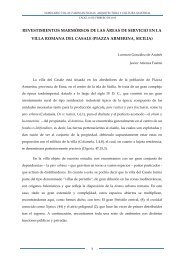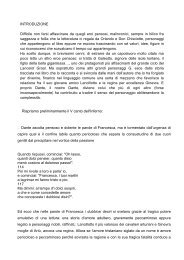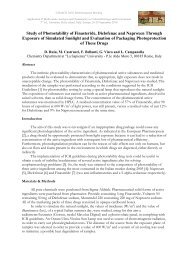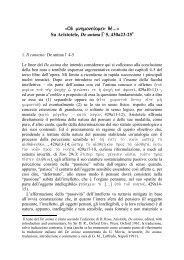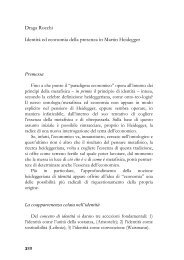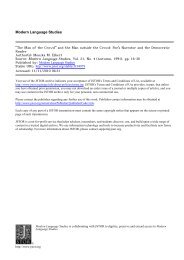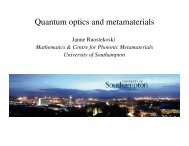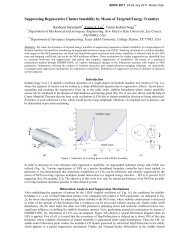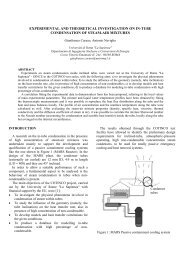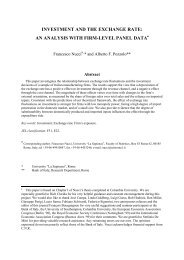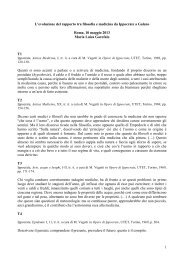Modal Properties of Surface and Leaky Waves ... - La Sapienza
Modal Properties of Surface and Leaky Waves ... - La Sapienza
Modal Properties of Surface and Leaky Waves ... - La Sapienza
Create successful ePaper yourself
Turn your PDF publications into a flip-book with our unique Google optimized e-Paper software.
BACCARELLI et al.: MODAL PROPERTIES OF SURFACE AND LEAKY WAVES PROPAGATING 41<br />
Fig. 7. Full-wave Brillouin diagram ( a% vs. a%) for the aHspatial<br />
harmonic <strong>of</strong> the fundamental TE mode propagating on a structure with 4 a<br />
PH, a HXIR , a HXQQV , a a HXT, corresponding to Fig. 4 <strong>of</strong><br />
[23]. Legend: proper solutions (solid line); improper solutions (dashed line). The<br />
edges <strong>of</strong> the first bound-mode triangle are represented by light dotted lines. The<br />
unperturbed „i modes <strong>of</strong> the parallel-plate waveguide (PPW) <strong>and</strong> grounded<br />
dielectric slab (GDS) are represented with gray dotted lines.<br />
waveguide, which supports a TEM wave with propagation constant<br />
equal to <strong>and</strong> with the magnetic or the electric field orthogonal<br />
to the PMC or PEC planes, respectively. A leaky mode<br />
may radiate into such a TEM wave propagating at an angle in<br />
the plane, so that modal cut<strong>of</strong>f for all the higher-order modes<br />
occurs when .<br />
In Fig. 8(b) the dispersion diagrams <strong>of</strong> the first two even<br />
modes <strong>and</strong> <strong>of</strong> the first odd mode are reported in a frequency<br />
range from 0 to 18 GHz. The mode labeled corresponds<br />
to the fundamental mode <strong>of</strong> the isolated microstrip, perturbed<br />
by the presence <strong>of</strong> the other array elements. It is always<br />
real proper <strong>and</strong> has cut<strong>of</strong>f at zero frequency. The mode labeled<br />
is the perturbed first higher-order mode <strong>of</strong> the isolated<br />
microstrip line [16]. It is proper real above its cut<strong>of</strong>f frequency<br />
<strong>and</strong> its phase constant is close to the phase<br />
constant <strong>of</strong> the unperturbed mode <strong>of</strong> the GDS above its<br />
cut<strong>of</strong>f frequency ; in fact, the TE modes <strong>of</strong> the<br />
GDS are perturbed very little by narrow strips placed along their<br />
direction <strong>of</strong> propagation, since their electric field is transverse<br />
to the strips. Below cut<strong>of</strong>f, the mode has a real improper<br />
continuation (with the spatial harmonic improper); such<br />
real improper solution originates, at lower frequencies, a complex<br />
improper solution. The mode labeled is an additional<br />
even mode with cut<strong>of</strong>f at zero frequency, where its phase constant<br />
is . It exists due to the presence <strong>of</strong> PMC lateral<br />
walls in the unit cell, thus it does not have a counterpart in the<br />
isolated microstrip line.<br />
In the next three figures, the evolution <strong>of</strong> the modes reported<br />
in Figs. 8(a) <strong>and</strong> (b) is shown as a function <strong>of</strong> the propagation<br />
angle in the range [0 ,90 ] at different frequencies. Results<br />
will be presented in the plane <strong>of</strong> the normalized phase constants<br />
( , ); by virtue <strong>of</strong> the symmetries <strong>of</strong> the structure,<br />
results for propagation angles outside the range [0 ,90 ] may<br />
be obtained by specular reflection <strong>of</strong> the reported curves with<br />
respect to the horizontal <strong>and</strong> vertical axes, which correspond to<br />
propagation at <strong>and</strong> at , respectively.<br />
Fig. 8. (a) Brillouin diagram ( a% vs. a%) for the fundamental TM <strong>and</strong><br />
TE modes propagating across the strips @0 aH A; direct modes (thick lines),<br />
reverse modes (thin lines); the shaded areas represent their stopb<strong>and</strong> regions.<br />
The edges <strong>of</strong> the first bound-mode triangle are represented by light dotted lines.<br />
On the right vertical axis also frequencies are reported in GHz. (b) Dispersion<br />
diagram ( a <strong>and</strong> a vs. frequency ) for the first two even <strong>and</strong> the<br />
first odd modes propagating along the strips @0 aWH A. Physical parameters:<br />
4 a PH, a HXIR , a HXQQV , a a HXP. Legend: normalized<br />
phase constant a or a%: proper real (solid line); improper real (dotted<br />
line); complex proper (short dashed line); complex improper (long dashed line).<br />
Normalized attenuation constant a : dashed line.<br />
The case is considered first. From Fig. 8(a)<br />
it may be seen that at this frequency the mode is real<br />
proper while the mode is below cut<strong>of</strong>f; on the other<br />
h<strong>and</strong>, from Fig. 8(b) it may be seen that at this frequency the<br />
modes <strong>and</strong> are above cut<strong>of</strong>f, while the mode<br />
is below cut<strong>of</strong>f in a real improper range. In Fig. 9 the<br />
evolution <strong>of</strong> these modes by varying the propagation angle<br />
from to may be observed in the range<br />
[0 ,90]. In particular, the mode becomes a ’grating<br />
mode,’ whose phase constant tends to infinity as tends<br />
to 0 , describing a slowly-varying periodic line almost parallel<br />
to the horizontal axis. On the other h<strong>and</strong>, the mode<br />
remains proper real with a bounded phase constant for<br />
all propagation angles, describing an approximately-elliptical<br />
curve outside the visible space, <strong>and</strong> finally becomes<br />
the fundamental mode at [see Fig. 8(a)]. This<br />
means that the surface wave related to this proper real mode<br />
may propagate at all angles on this structure. Finally, two real<br />
improper branches originate from the vertical axis



